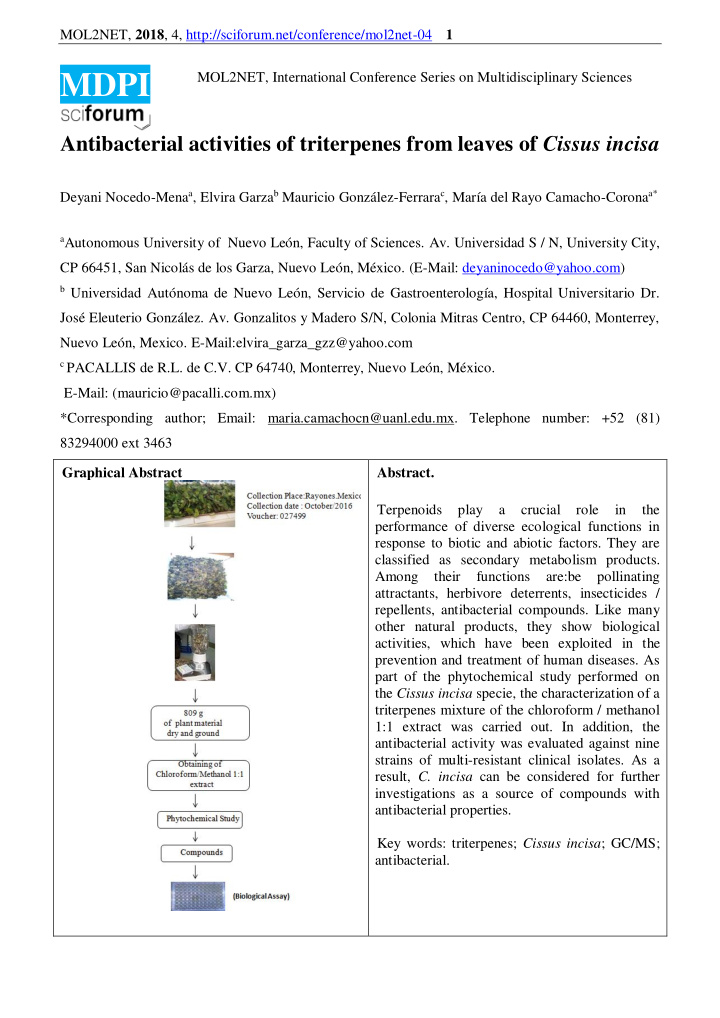



MOL2NET, 2018 , 4, http://sciforum.net/conference/mol2net-04 1 MDPI MOL2NET, International Conference Series on Multidisciplinary Sciences Antibacterial activities of triterpenes from leaves of Cissus incisa Deyani Nocedo-Mena a , Elvira Garza b Mauricio González-Ferrara c , María del Rayo Camacho-Corona a* a Autonomous University of Nuevo León, Faculty of Sciences. Av. Universidad S / N, University City, CP 66451, San Nicolás de los Garza, Nuevo León, México. (E-Mail: deyaninocedo@yahoo.com) b Universidad Autónoma de Nuevo León, Servicio de Gastroenterología, Hospital Universitario Dr. José Eleuterio González. Av. Gonzalitos y Madero S/N, Colonia Mitras Centro, CP 64460, Monterrey, Nuevo León, Mexico. E-Mail:elvira_garza_gzz@yahoo.com c PACALLIS de R.L. de C.V. CP 64740, Monterrey, Nuevo León, México. E-Mail: (mauricio@pacalli.com.mx) *Corresponding author; Email: maria.camachocn@uanl.edu.mx. Telephone number: +52 (81) 83294000 ext 3463 Graphical Abstract Abstract. Terpenoids play a crucial role in the performance of diverse ecological functions in response to biotic and abiotic factors. They are classified as secondary metabolism products. Among their functions are:be pollinating attractants, herbivore deterrents, insecticides / repellents, antibacterial compounds. Like many other natural products, they show biological activities, which have been exploited in the prevention and treatment of human diseases. As part of the phytochemical study performed on the Cissus incisa specie, the characterization of a triterpenes mixture of the chloroform / methanol 1:1 extract was carried out. In addition, the antibacterial activity was evaluated against nine strains of multi-resistant clinical isolates. As a result, C. incisa can be considered for further investigations as a source of compounds with antibacterial properties. Key words: triterpenes; Cissus incisa ; GC/MS; antibacterial.
MOL2NET, 2018 , 4, http://sciforum.net/conference/mol2net-04 2 Results and Discussion Figure 1 . Triterpenes characterized by GC / MS in the leaves of Cissus incisa 1) C 32 H 52 O 2 4) C 32 H 52 O 2 PM:468 g/mol PM:468 g/mol 2) C 30 H 50 O PM:426 g/mol 5) C 32 H 52 O 2 PM:468 g/mol 6) C 32 H 52 O 2 3) C 31 H 48 O 3 PM:468 g/mol PM:468 g/mol 1) Urs-12-en-3- ol,acetate ,3β 2) 4,4,6a,6b,8a,11,11,14b-octametil-1,2,3,4,4a,5,6,6a,6b,7,8,8a,9,10,11,12b,13,14,14a,14b- icosahidropicen-3-ol 3) (M)urs-12-en-24- oic acid,3-oxo-,methyl ester,(+) 4) (M)Lup-20(29)-en-3- ol,acetate,(3β) 5) (M)13,27-cycloursan-3-ol, acetate, (3 β ,13 β ,14 β ) 6) (R)Lanosta-8,24-dien-3- ol,acetate,(3β)
MOL2NET, 2018 , 4, http://sciforum.net/conference/mol2net-04 3 Table 1 . Results of the antibacterial activity of the triterpenes mixture of C. incisa leaves Tested Strains MIC(µg/mL) Methicillin- resistant Staphylococcus aureus >200 Linezolid- resistant Staphylococcus epidermidis >200 Vancomycin – resistant Enterococcus faecium, 200 Acinetobacter baumannii resistant to carbapenems 200 coli producing extended-spectrum beta >200 Escherichia lactamase Pseudomona aeruginosa resistant to carbapenems, 200 Klebsiella pneumoniae NDM-1+ resistant to carbapenems >200 and broad-spectrum cephalosporins Klebsiella pneumoniae producing extended-spectrum beta >200 lactamase Klebsiella pneumoniae resistant to oxacillins 200 References 1. Tetali S. D. Terpenes and isoprenoids: a wealth of compounds for global use. Plant, 2018 . Epub Nov 22,. DOI: 10.1007/s00425-018-3056-x 2. Vishnuthari, N., and Sripathi, S. K. GC-MS analysis of hexane extract of stems and roots of the ethnomedicinal plant Cissus quadrangularis Linn. J. Chem. Biol. Phys. Sci . 2015 , 5, 3954 – 3963. 3. Rasamiravaka, T., Ngezahayo, J., Pottier, L., Ribeiro, S. O., Souard, F., Hari, L., Stévigny, C., El Jaziri, M., and Duez, P. Terpenoids from Platostoma rotundifolium (Briq.) A. J. paton alter the expression of quorum sensing-related virulence factors and the formation of biofilm in Pseudomona aeruginosa PAO1. Int. J. Mol. Sci , 2017, 18(6), 1-22. 4. Rajavel, T., Mohankumar, R., Archunan, G., Ruckmani, K. and Devi, K. P. Beta -sitosterol and Daucosterol (phytosterols identified in Grewia tiliaefolia ) perturbs cell cycle and induces apoptotic cell death in A549 cells. Sci. Rep , 2017, 7, 1 – 15. 5. Abdel-Raouf, N.,Al-Enazi, N.M., Al-Homaidan, A.A.,Ibraheem, I.B.M.,Al-Othman, M. R., and Hatamleh, A. A. Antibacterial β -amyrin isolated from Laurencia microcladia . Arab. J. Chem, 2015 , 8(1), 32 – 37. 6. Shan, L.Y., Thing, T.C., Ping, T. S., Awang, K., Hashim, N. M., Nafiah, M. A., and Ahmad, K. Cytotoxic, Antibacterial and antioxidant activity of triterpenoids from Kopsia singapurensis Ridl. J. Chem. Pharm. Res , 2014, 6(5), 815 – 822.
Recommend
More recommend